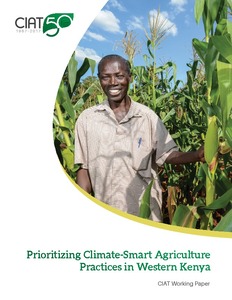Prioritizing climate-smart agriculture practices in Western Kenya.
A climate-smart agriculture (CSA) prioritization exercise in Western Kenya was carried out as part of the activities in the CIAT-led research project on ‘Climatesmart soil protection and rehabilitation in Western Kenya’, funded by GIZ. This project aims to encourage sustainable approaches to promote soil protection and rehabilitation of degraded soil in Benin, Burkina Faso, Ethiopia, India and Kenya. It also supports policy development for soil rehabilitation, soil information, and extension systems.
A two-day regional workshop with 45 participants was held in Western Kenya; participants were local agricultural experts, representatives of agriculture related local NGOs and farmers from Bungoma, Kakamega and Siaya counties. Six farmers were invited from each of the five farm typologies (that had previously been identified by this project): i) smallscale mixed subsistence; ii) medium-scale mixed with commercial horticulture; iii) medium-scale mixed with commercial dairy; iv) medium-scale mixed with commercial cereal; and v) large-scale commercial farming. Separate focus group discussions were held with farmers and local experts, respectively to explore the differences between stakeholders.
The workshop modules included: validation of the typologies in the three counties; CSA indicator selection; development of a short list of agricultural practices appropriate for each farm type; and climatesmartness assessment based on the three CSA pillars (i.e. production, adaptation and mitigation). Practices were prioritized using pairwise ranking and information on the potential benefits of practices by stakeholder was also documented.
This study highlights the value of evaluating which practices were preferred in a local context and highlights the climate smartness of these practices based on desired objectives by local experts and farmers. Efforts to increase soil restoration and rehabilitation in Western Kenya should target the prioritized practices in each farm type to achieve high adoption rates and attain CSA goals. In addition, barriers highlighted by the stakeholders should be considered. Assessing practices against the CSA pillars helps to ensure that prioritized practices can also provide win–win or co-benefits to climate change adaptation and mitigation.
Implementing this study was a way of testing the CSA prioritization framework developed by CIAT in 2014, which led to the development of a revised CSA prioritization process.

